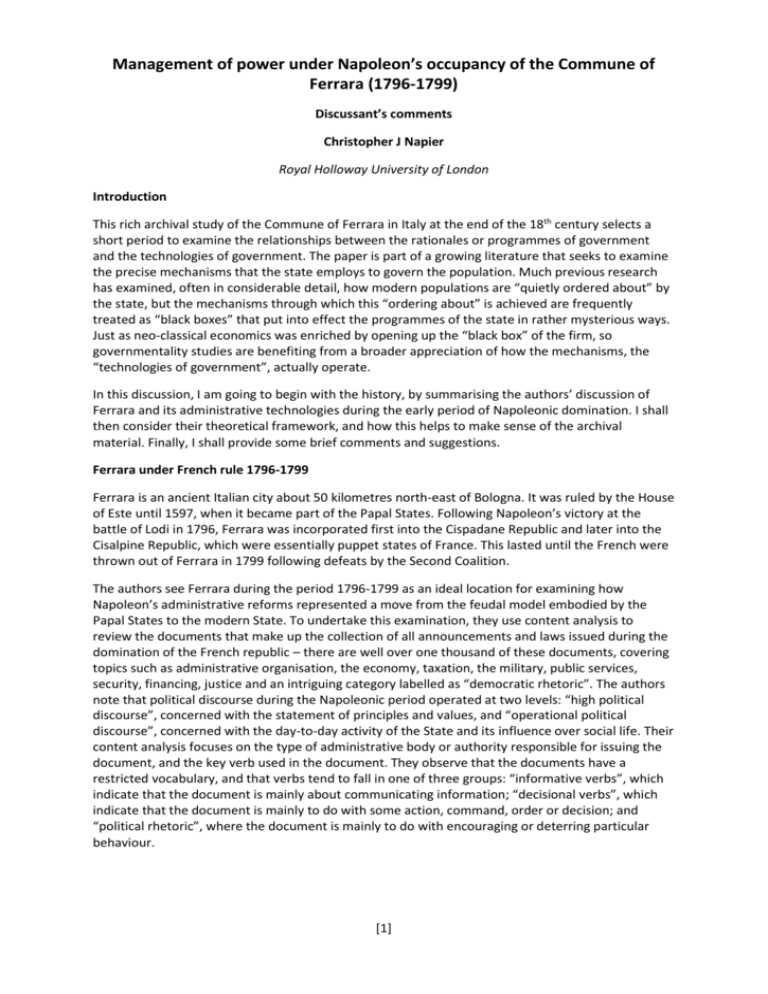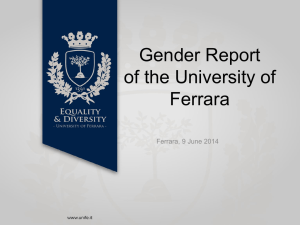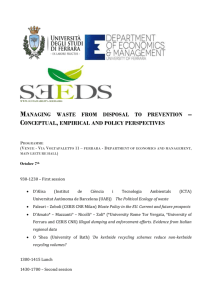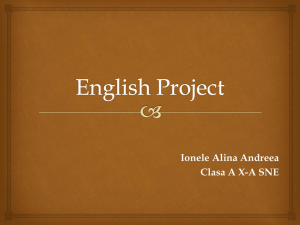view comments
advertisement

Management of power under Napoleon’s occupancy of the Commune of Ferrara (1796-1799) Discussant’s comments Christopher J Napier Royal Holloway University of London Introduction This rich archival study of the Commune of Ferrara in Italy at the end of the 18th century selects a short period to examine the relationships between the rationales or programmes of government and the technologies of government. The paper is part of a growing literature that seeks to examine the precise mechanisms that the state employs to govern the population. Much previous research has examined, often in considerable detail, how modern populations are “quietly ordered about” by the state, but the mechanisms through which this “ordering about” is achieved are frequently treated as “black boxes” that put into effect the programmes of the state in rather mysterious ways. Just as neo-classical economics was enriched by opening up the “black box” of the firm, so governmentality studies are benefiting from a broader appreciation of how the mechanisms, the “technologies of government”, actually operate. In this discussion, I am going to begin with the history, by summarising the authors’ discussion of Ferrara and its administrative technologies during the early period of Napoleonic domination. I shall then consider their theoretical framework, and how this helps to make sense of the archival material. Finally, I shall provide some brief comments and suggestions. Ferrara under French rule 1796-1799 Ferrara is an ancient Italian city about 50 kilometres north-east of Bologna. It was ruled by the House of Este until 1597, when it became part of the Papal States. Following Napoleon’s victory at the battle of Lodi in 1796, Ferrara was incorporated first into the Cispadane Republic and later into the Cisalpine Republic, which were essentially puppet states of France. This lasted until the French were thrown out of Ferrara in 1799 following defeats by the Second Coalition. The authors see Ferrara during the period 1796-1799 as an ideal location for examining how Napoleon’s administrative reforms represented a move from the feudal model embodied by the Papal States to the modern State. To undertake this examination, they use content analysis to review the documents that make up the collection of all announcements and laws issued during the domination of the French republic – there are well over one thousand of these documents, covering topics such as administrative organisation, the economy, taxation, the military, public services, security, financing, justice and an intriguing category labelled as “democratic rhetoric”. The authors note that political discourse during the Napoleonic period operated at two levels: “high political discourse”, concerned with the statement of principles and values, and “operational political discourse”, concerned with the day-to-day activity of the State and its influence over social life. Their content analysis focuses on the type of administrative body or authority responsible for issuing the document, and the key verb used in the document. They observe that the documents have a restricted vocabulary, and that verbs tend to fall in one of three groups: “informative verbs”, which indicate that the document is mainly about communicating information; “decisional verbs”, which indicate that the document is mainly to do with some action, command, order or decision; and “political rhetoric”, where the document is mainly to do with encouraging or deterring particular behaviour. [1] Discourses Based on the collected documents and on the constitution of the Cisalpine Republic and some letters from the French ambassador, the authors identify six metaphors that underpin the high political discourse. First, the French Republic is stated to be the friend of the Cisalpine Republic; secondly, the search for happiness is asserted as an intrinsic human characteristic; thirdly, the State is legitimised as the outcome of a social contract between free citizens; fourthly, a dualism of good versus evil is established whereby enemies are characterised as evil and the French Republic is identified as good; fifthly, the need to tailor the constitution to the size and maturity of the community is symbolised as a suit of armour; and finally, the need for balance between different branches of public service is symbolised as a tree of liberty, where there needs to be a correct relationship between the tree’s “roots” – the taxes derived from the citizenship – and the foliage – the operations of the state. It is worth noting that the population is addressed as citizens, rather than as subjects, indicating the different relationship between state and population introduced alongside French occupation. This relationship is manifested through a range of technologies of government, with the public administration being established as “an accountable and objective provider of services for the citizens”. At the operational level, the documents reveal attention to topics such as the management of the economy, culture (education, religion and leisure activities), healthcare, police and the administration of justice, and maintenance of the army. In practice, the operational discourse tended to emphasise the needs of the army and the requirement to administer and collect taxes, rather than the more social and cultural aspects. The authors see a tension between the desire to create an efficient financial and military administration and the need to inculcate higher values – failure to do the latter meant that the technologies of government were not well embedded, which made resistance to Napoleonic rule feasible, and ultimately successful. Practices Much of the literature that applies a Foucauldian notion of governmentality to study particular settings is aware that terms such as “State” and “Government” are multi-faceted. In the modern state, the government, identified as the ruling individual or cohort, rarely acts directly on the population. Instead, it acts at a distance, through mechanisms or technologies of governing. This can be seen in the context of the Commune of Ferrara. The ultimate ruler, who may be identified personally as Napoleon or more generally as the French Republic, utilises the Cisalpine Republic, ostensibly an independent state but more practically a dependent of France, and grants the Cisalpine Republic various responsibilities. Below the Republic are a number of Departments (on the French model), which act as intermediate organs of government, below the Departments are various districts, and at the bottom of the structure of government are the Communes. These have responsibility for maintenance of local roads and buildings, for local police, and local healthcare, and are charged with executing orders from the Department in which they are situated. So it is the Commune that directly orders the population around, acting on the body through the provision of healthcare and the discipline of the National Watch. This is the standard Napoleonic system, which will be introduced in other parts of Europe and will wipe out previous feudal jurisdictions. The authors find that the intermediate government level was increasingly involved in promulgating regulations, leaving the Commune merely as an executor of these regulations. This is seen as a general feature of the French administrative model, with a constant tendency towards centralisation. The higher levels of government have the constitutional power to overrule lower levels. This is borne out through the linguistic analysis of documents: nearly two-thirds of the “decisional” documents emanate from central government, while just over half of the “informative” documents come from intermediate government. The Commune is the main provider of “rhetorical” documents, suggesting that its main role is to rationalise the orders of higher levels of government [2] and exhort citizens to follow them. On the other hand, the executive role of the Commune is evidenced by a rapidly growing salary bill for local administrators and increasing specificity as regards their rights and duties. Accounting An important aim of the new administrative system was to eliminate the inefficiencies of the previous fiscal practices of the Papal States. Feudal systems of state finance frequently allowed for arbitrary privileges and other anomalies, and control over expenditure was often weak. The Constitution of the Cisalpine Republic established a system of centralised control over expenditure, with monitoring of intermediate and commune-level governments against budgets and annual reporting. At the same time, lower-level governments could raise taxes only with the authority of the central government. Detailed revenue and expenditure classifications relating to different levels of government were set out, while a census was required every ten years to ensure that allocations of expenditure were firmly based. Counting the population in a systematic way is one of the most obvious signs of a rationally-grounded governmentality. Many of the financial documents examined by the authors show the amounts of taxes collected, analysed according to the hierarchy of government. For example, a summary of tax receipts by department can be linked to more detailed summaries of tax receipts from the various districts making up a given department. Most of the tax collected by the Cisalpine Republic went to support the army or was sent to the central French government, and the accounting system can be seen as driven by a need to maximise tax collections and minimise expenditure. Theorisation The authors draw on governmentality as an interpretive framework, and they follow the approach of Miller and Rose (1990) and Robson (1991), highlighting the role played by language, discourse and rhetoric in translating the general programmes of government into the particular ways in which the population is governed. The “discursive” dimension of governmentality is seen as manifesting itself in terms of how power is distributed among different levels or organs of government, leading to a distribution of tasks, and how the activities of the population, and of the organs of government, are captured through systems of recording and reporting. However, does governmentality operate in an unproblematic and linear manner, or are there disjunctures, resistances, even overthrowings? The authors argue that there is a clear disjuncture between the “high political discourse” and the “operational political discourse”. The high discourse emphasises democracy, citizenship, transparency and downward accountability. When this is operationalised, however, we observe centralisation, bureaucracy, and upward accountability. The process of government is constrained by the need to raise taxes to finance the army of occupation and France’s military forces elsewhere, and to subsidise France at the expense of the Cisalpine Republic. The good citizen is not one who participates in government but one who contributes through taxes to maintaining the French armies and state. Comments This is a rich study grounded in extensive archival material. However, it suffers from an issue that affects several studies using a Foucauldian notion of governmentality – the population itself is often not made visible. This may be an artefact of the archive, where formal documents such as laws and decrees are likely to be preserved, but evidence relating to how these laws and decrees were put into effect, and the extent to which they were enforced on or against the population, is less likely to survive. We know that there was resistance and ultimately the French were thrown out, but the details of this are missing from the paper, and it is not possible to determine how far the centralising tendencies of government in the Cisalpine Republic meant that the operations of government were felt by the population as exercises of power little different from the population’s experiences under the more feudal rule of the Popes. The authors suggest that the high political discourse was, at the [3] level of the commune, rhetorical rather than functional, and it is possible that, at this local level, the population’s reaction was (to quote Pete Townshend’s lyric): “Meet the new boss, same as the old boss”. This would be particularly appropriate if the local administrators and bureaucrats were in general the same people who fulfilled equivalent roles for the previous Papal administration. Ironically, despite the rebellion, the French regained control over Ferrara following Napoleon’s victory at the battle of Marengo in 1801, and it is likely that the system under review in the paper was reintroduced. This may suggest that lack of linearity – of well-articulated linkages between the higher-level discourses and programmes of government and their operationalization at the local level – does not matter so long as the State can exercise physical power over the population through effective armies of occupation or police forces. This can provide a context in which mechanisms of government can become embedded, normalised and naturalised, so that they persist even after the physical discipline is removed. So perhaps Ferrara is not the story of resistance that the authors suggest in their conclusion, implying that their investigation will be complete only when they explore the period that follows their study. This will, I fear, require yet more Herculean labour in the archives. References Miller, P. and Rose, N. (1990) Governing economic life. Economy and Society 19(1): 1-31. Robson, K. (1991) On the arenas of accounting chang: The process of translation. Accounting, Organizations and Society 16 (5/6): 547-570. [4]








